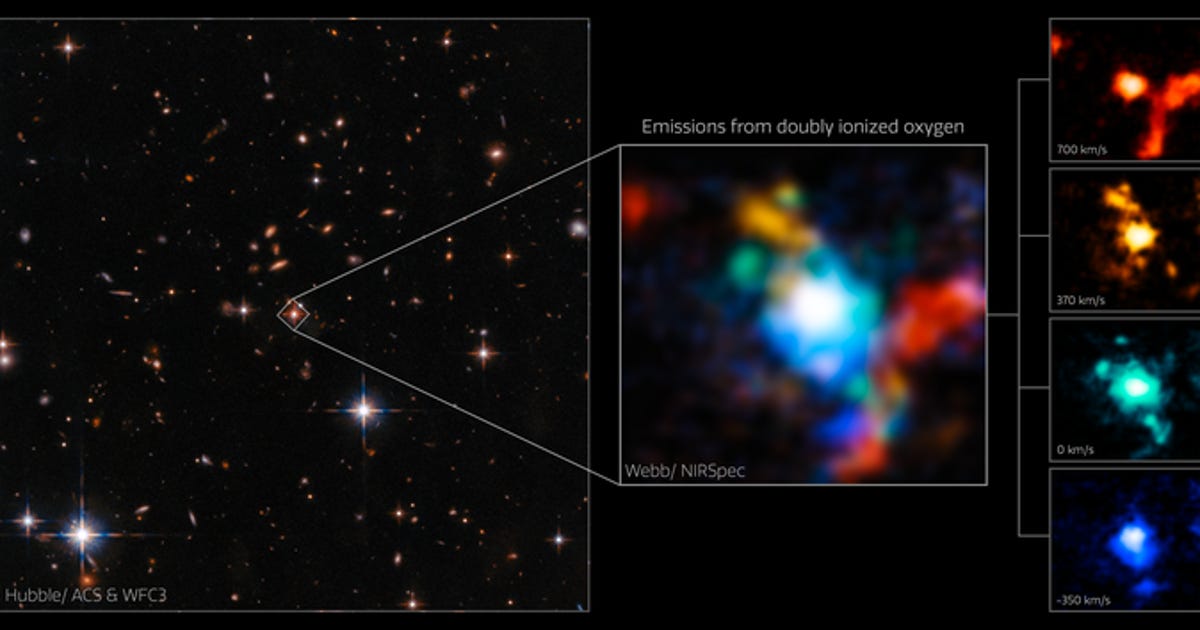NASA’s multibillion-dollar James Webb Space Telescope reached its gravitational safe space a million miles from Earth in January. It began taking our breath away in July.
One by one, astonishing vignettes of a glimmering universe started decking our screens, each image somehow more thought-provoking and beautiful than the last. However, I’d argue the telescope’s seminal masterpieces will always occupy a special corner of our hearts.
Toffee-hued cliffs of the Carina Nebula and fairy-dusted galaxies of Stephan’s Quintet are ever ingrained as the JWST’s first dance with deep space, and our first dance with the JWST. That said, thanks to data collected by NASA’s Chandra X-ray Observatory, the agency managed to enhance some of those brilliant JWST starter pics.
With positively electrifying results.
Behold, a new and improved version of the JWST’s Carina Nebula, Stephan’s Quintet, and deep field SMACS 0723.3–7327 from image set No. 1, as well as an updated iteration of the slightly more recent Cartwheel Galaxy portrait.
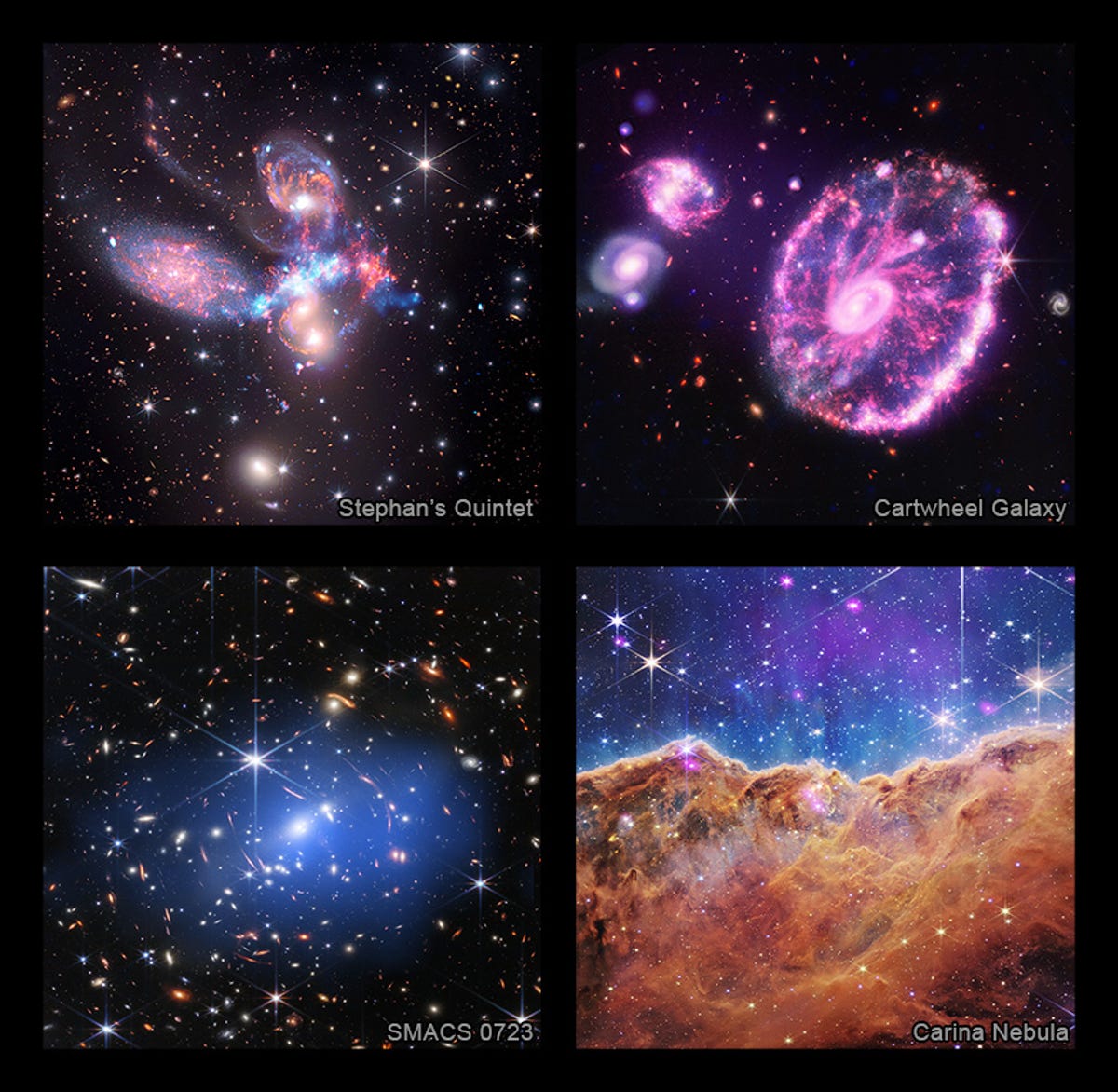

These are the four composite images NASA created with both JWST and Chandra X-ray data.
NASA/CXC/SAO/ESA/CSA/STScI/JPL-Caltech
Breaking down JWST pics 2.0
On July 11, President Joe Biden presented humanity with its first JWST treasure, informally dubbed Webb’s First Deep Field (and formally known by its robot name, SMACS 0723.3-7327).
Let’s zoom in to the 2.0 of this sparkly exhibition first.
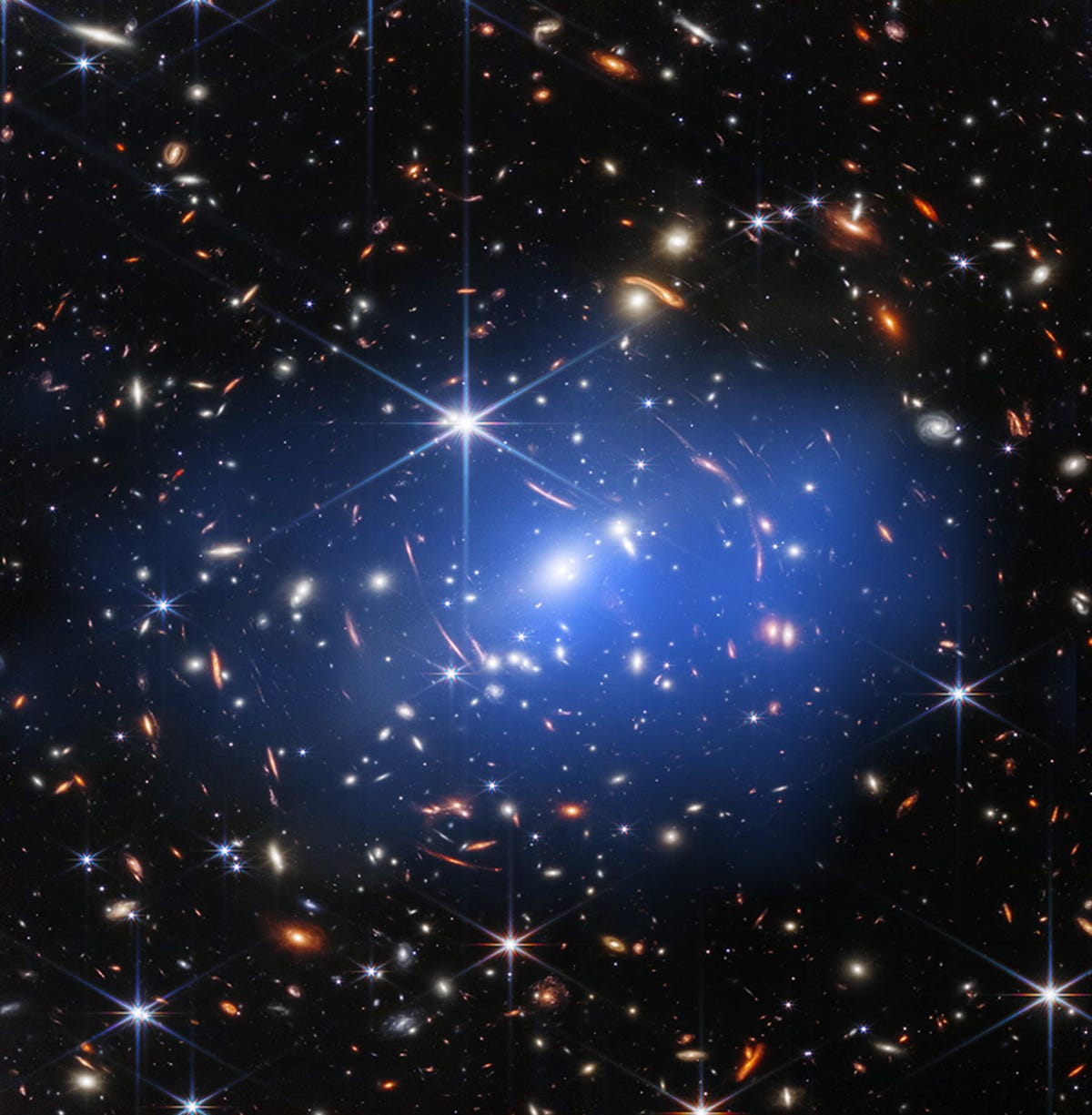

A composite image of SMACS 0723.3-7327.
NASA/CXC/SAO/ESA/CSA/STScI
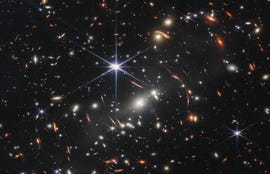
 Enlarge Image
Enlarge ImageWebb’s First Deep Field with only JWST observations.
NASA, ESA, CSA, and STScI
When I laid eyes on this deep field for the first time — after NASA’s obscenely long delay in unveiling it, a wait weirdly scored by ambient chillhouse music — my jaw dropped like one of those comic book cartoon animals.
These aren’t stars you’re looking at; they’re galaxies located about 4.2 billion light-years away.
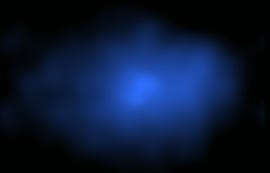
 Enlarge Image
Enlarge ImageThe same deep field with just Chandra observations.
NASA/CXC/SAO
Warped streaks at the center of the image are the result of extensive gravitational lensing, a phenomena predicted by Einstein’s general relativity and therefore visual proof of the mind-bending principle.
Shown as a blue haze diffusing from the middle of the image, this gas reaches tens of millions of degrees Celsius and has a staggering mass of about 100 trillion times that of the sun. NASA even estimates the gas reservoir to be several times more massive than every galaxy in this cluster.
In a way, realizing the size of this region forces you to think about how deep this deep field really goes.
Next up is Stephan’s Quintet, a gaggle of five galactic realms, four strung together by their gravitational auras.
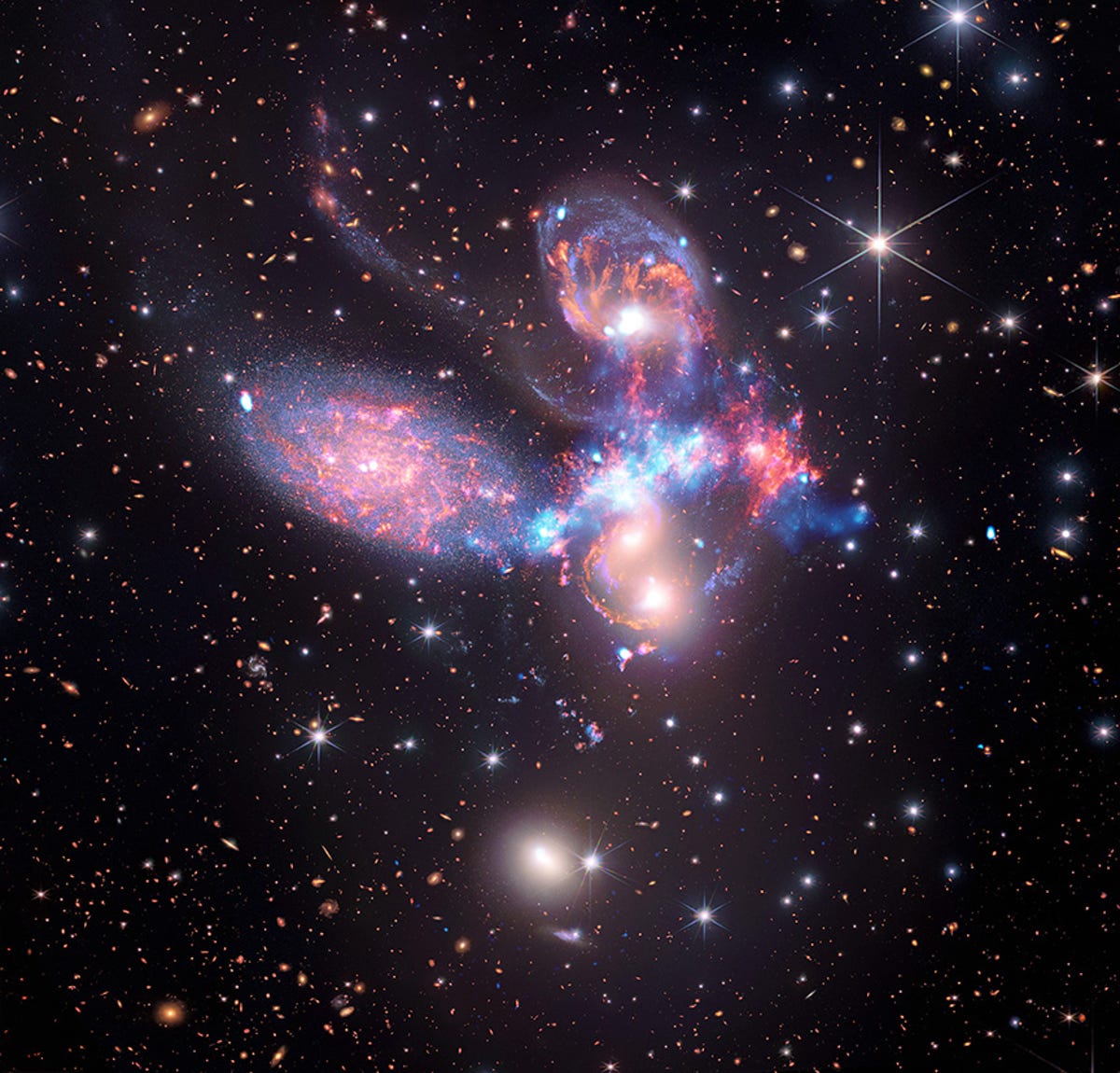

A composite image of Stephan’s Quintet, made with both JWST infrared and Chandra X-ray data.
NASA/CXC/SAO/ESA/CSA/STScI

 Enlarge Image
Enlarge ImageStephan’s Quintet with only JWST observations.
NASA/ESA/CSA/STScI
JWST data shows up in this picture as red, orange, yellow, green and blue streaks, NASA said. Coded in these shades, you can see galactic trails of gas and growing baby stars speckling the dark background of space.
But the piercing baby blue highlight at the galactic intersection, right at the center of this image, comes from Chandra X-ray data.
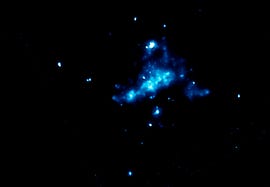
 Enlarge Image
Enlarge ImageStephan’s Quintet with only Chandra observations.
NASA/CXC/SAO
The observatory found a shockwave that heats gas to tens of millions of degrees, NASA explains, exuded as one of the galaxies passes through another with a speed of 2 million miles per hour. The agency also points out some data taken by NASA’s now-retired Spitzer Space Telescope in red, green and blue — infrared information like the kind the JWST works with.
Next, the Carina Nebula.
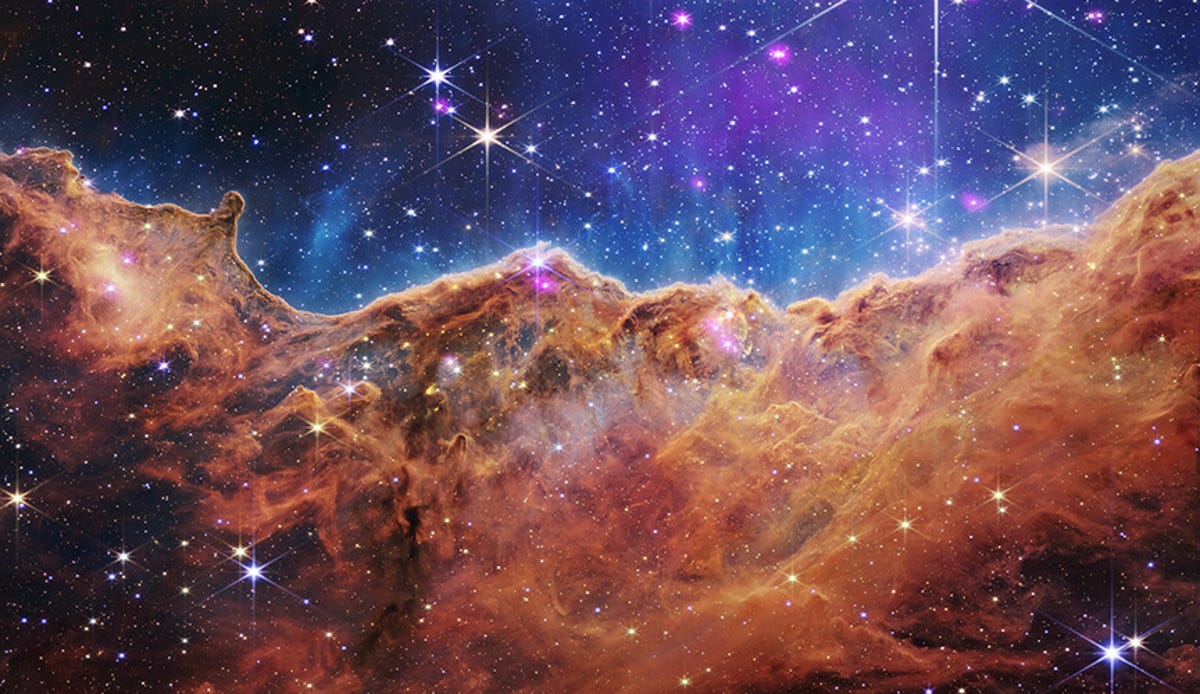

A composite image of the Carina Nebula, made with JWST and Chandra data.
NASA/CXC/SAO/ESA/CSA/STScI

 Enlarge Image
Enlarge ImageCarina Nebula with only the JWST’s infrared lens.
NASA/ESA/CSA/STScI
As a science writer, it never ceases to make me smile when I tell someone about my job in our post-JWST-launch world and they immediately reach to show me their JWST iPhone background. Or, at least a saved picture from the ‘scope in their camera roll. Some choose the deep-field drama for phone wallpaper (like me) but I’d say the favorite is JWST’s Carina Nebula masterpiece.

 Enlarge Image
Enlarge ImageCarina Nebula with only Chandra X-ray observations.
NASA/CXC/SAO
The Carina Nebula is a star factory, basically, where flaming balls of gas are either being born or waiting to die, and this image is a zoomed-in section of it. Data from the JWST pretty much makes up the backbone of this portrait — the melty-looking, red-orange landscape and indigo region that looks like a “sky.” It’s not a sky, to be clear. It’s not even blue in real life — space images are typically colorized for science reasons.
“These are mostly stars located in the outer region of a star cluster in the Carina Nebula with ages between 1 and 2 million years old, which is very young in stellar terms,” NASA said.
And Chandra’s contribution here is how bright each star looks, NASA said.
Young stars, per the agency, are much brighter in X-rays than old stars. This also means X-rays can help us tell whether there are any Milky Way galaxy stars present in this picture, simply because they fall along the line of the JWST’s vision.
“The diffuse X-ray emission in the top half of the image likely comes from hot gas from the three hottest, most massive stars in the star cluster. They are all outside the field of view of the Webb image,” NASA said.
Last but not least, the Cartwheel Galaxy.
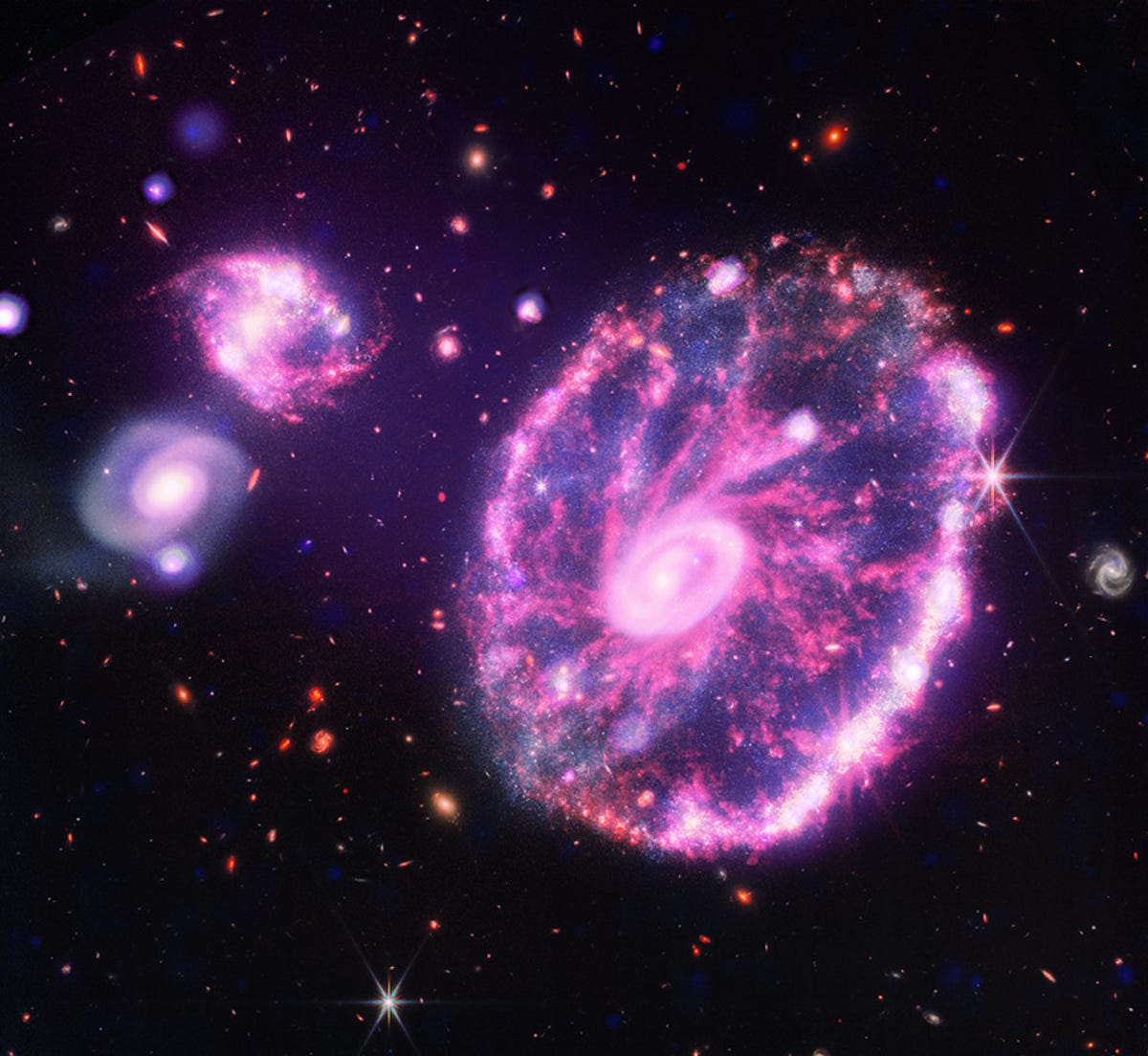

A composite image of the Cartwheel Galaxy made with both JWST infrared and Chandra X-ray observations.
NASA/CXC/SAO/ESA/CSA/STScI
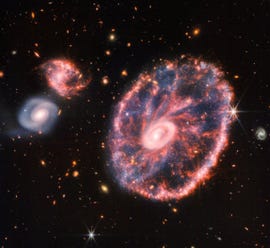
 Enlarge Image
Enlarge ImageA purely JWST view of the Cartwheel Galaxy.
NASA/ESA/CSA/STScI
The JWST’s Cartwheel Galaxy’s image came out just under a month after the other three we’ve discussed, but its reception was just as spritely. It’s easy to see why. I mean, it looks like a cosmic, glow-in-the-dark ferris wheel. That shape, per NASA, is thanks to a collision it had some 100 million years ago with a smaller galaxy, serendipitously the same crash that spurred this realm to begin forming stars.
Again, the JWST’s original image serves as the structure of this image, the blue and purple areas come from Chandra observations of superheated gas, individual exploded stars, neutron stars and even black holes pulling material from companion stars.
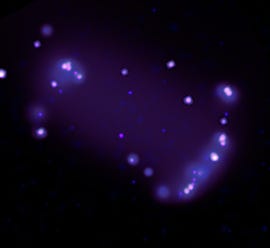
 Enlarge Image
Enlarge ImageCartwheel Galaxy, as seen through the lens of the Chandra X-ray Observatory.
NASA/CXC/SAO
But beyond offering us yet another stunning lens on the universe, the collaboration between NASA’s JWST and Chandra Observatory sets an important message in stone.
“Webb … will not pursue its exploration of the universe on its own,” NASA said. “It is designed to work in concert with NASA’s many other telescopes as well as facilities both in space and on the ground.”
In fact, elsewhere in the higher dimension of telescope collabs, the JWST worked with Hubble to present us with an ethereal view of a dusty galactic pair.
Perhaps one day, all our powerful telescopes’ images will be overlain to show us the universe in its purest form.

